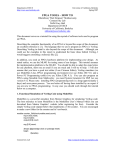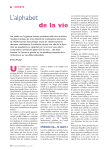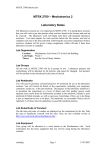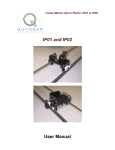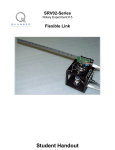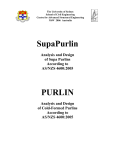Download Inverted Pendulum Compensator Design via State Space
Transcript
EE128 Fall 2008 University of California, Berkeley Lab 4 Rev. 1.00 Lab 4: Inverted Pendulum Compensator Design via State Space I. Objective The goal of this lab is: a. To design a controller using state space (modern) control techniques so as to balance the pendulum about the vertical equilibrium. II. Software and equipment 1. Computer with MATLAB, Simulink, WinCon and Real Time Workshop installed. 2. ee128 student account III. Theory 1. Model of the Plant Figure 1 below shows the inverted pendulum system's free body diagram from the previous lab for reference. Figure 1. Pendulum system free body diagram [5]. IV. Prelab 1. Plant model From your previous lab, write down your final plant model. 2. Controller design [4] As you deduced from lab 3, your open-loop plant is unstable. There are many methods to controller design via state space: 1. If you know the desired location of closed loop poles, you can use the “place” or “acker” command (acker stands for Ackerman’s Formula) in MATLAB. EE128 Fall 2008 University of California, Berkeley Lab 4 Rev. 1.00 2. Another option is to use the “lqr” (Linear Quadratic Regulator) function. This will give you the optimal controller (under certain assumptions called the controllability criterion, check your textbook for more details). We will be using this approach to pick a controller. The LQR function allows you to choose two parameters, R and Q, which will balance the relative importance of the input and state in the cost function that you are trying to optimize (type “help lqr” in MATLAB for more details). The simplest case is to assume R really small (say 3e-4) and Q = C’*C. Based on this approach, write a simple MATLAB m-script that gives you the values of the feedback based on your plant model and LQR. However, your controller gains are in V/m and V/rad. Convert these to V/cm and V/degree. Then, implement this controller in lab. BEFORE YOU IMPLEMENT THE CONTROLLER, MAKE SURE YOU UNDERSTAND THE CONTROLLER BLOCK DIAGRAM YOU OBTAINED FROM YOUR TA! V. Lab CAUTION: DO NOT TRANSFER DATA TO AND FROM THE WINDOWS 98 MACHINE. THIS MACHINE SHOULD NOT BE PUT ON THE EECS NETWORK! 0. Sign up for a 1-hour time slot with the TA. 1. Controller Implementation The TA will provide you with a template for controller implementation, insert the gains from your LQR at the appropriate place. VI. Revision History Semester and Revision Summer 2008 Rev. 1.00 Author(s) Bharathwaj Muthuswamy Comments 1. Formatted writeup into different sections. 2. Typed up solutions VII. References 1. Franklin, Gene F., Powell, David J. and Emami-Naeini Abbas. Feedback Control of Dynamic Systems. 5th Edition. 2006, Prentice-Hall Inc. 2. UCSB course ECE147B: Digital Control Systems Theory and Design. Available online: http://www.ece.ucsb.edu/~roy/cgi-bin/makepage.pl?nav=course_147b June 27th 2008. 3. Quanser Consulting Inc. Self Erecting IP User’s Manual, 1996. 4. Control Tutorials for MATLAB. Available Online: http://www.ee.usyd.edu.au/tutorials_online/matlab/examples/pend/invpen.html June 27th 2008



